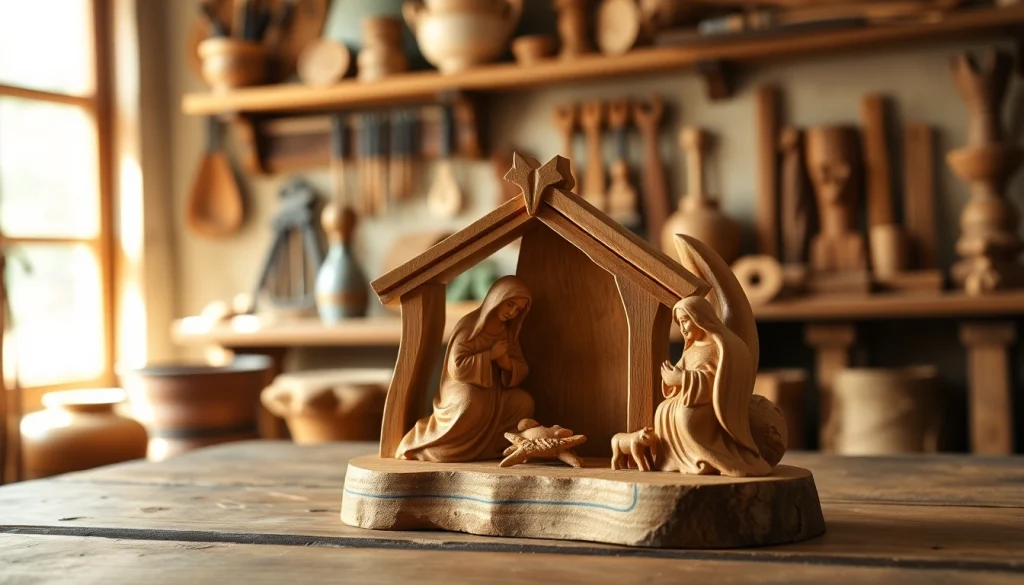Understanding Olive Wood Carvings
Olive wood carvings are not merely art pieces; they embody rich traditions, deep cultural significance, and a timeless connection to the sacred lands where they are crafted. Originating primarily from the olive trees of the Holy Land, especially in Bethlehem and Jerusalem, these carvings are renowned for their intricate craftsmanship and spiritual essence. The artistry lies not just in the final product but in the historical and cultural narratives that breathe life into each piece. This article delves deep into the realm of olive wood carvings, exploring their history, unique characteristics, traditional techniques, and the artisans who keep this age-old craft alive. We will also touch upon their spiritual significance and the cultural impact they wield in today’s world. Whether you’re a collector, a faith devotee, or simply an admirer of fine art, there’s much to discover in the world of olive wood carvings.
The History and Significance of Olive Wood in Art
The history of olive wood carving is as ancient as the olive tree itself. The olive tree has been a vital part of life in the Mediterranean and Middle Eastern regions for thousands of years, often symbolizing peace, longevity, and sustenance. In Christian theology, the olive tree holds significant symbolism; it represents the peace of God and is often linked with stories of the biblical figures. Carving from these sacred trees began at least as far back as biblical times, primarily in regions where olive trees thrived.
Traditionally, these carvings served not only decorative purposes but also religious functions. Regions like Bethlehem became known for their intricate nativity scenes and religious figures, reflecting both the craftsmanship of local artisans and the religious devotion of their community. This art form evolved over centuries but remained rooted in its cultural tapestry, echoing the enduring stories of the land.
Unique Characteristics of Olive Wood as a Medium
Olive wood has unique attributes that make it an exceptional medium for carving. Its beautiful, swirling grain pattern and varied color palette—from rich golds to deep browns—provide an aesthetic appeal that is hard to replicate. The tight grain structure of olive wood also lends itself to a smoother finish, offering an exquisite feel and look, making each carving a true work of art.
Moreover, olive wood is incredibly durable yet easy to manipulate, making it a favorite among artisans. Once shaped, olive wood retains its warm, natural oils, which contribute to its luster and durability over time. These factors not only enhance the beauty of the carvings but also ensure their longevity, meaning they can be cherished as family heirlooms for generations.
Traditional Techniques Used in Olive Wood Carving
Carving olive wood is a skill-intensive process that requires patience and meticulous attention to detail. The traditional techniques often used by artisans have been passed down through generations, preserving the authenticity of this art form. One of the key techniques is direct carving, where artisans work with hand tools to shape the wood slowly, allowing the unique grain patterns to become part of the design.
Another technique involves steam bending, which helps soften the wood fibers to create intricate curves and shapes. This method is particularly useful in producing complex forms like crosses and religious figures. The use of chisels and knives, along with patience and practice, results in beautifully crafted pieces that resonate spiritually and artistically.
The Spiritual Connection of Olive Wood Carvings
Olive Wood Carvings in Religious Art
In the realm of religious art, olive wood carvings hold a sacred place. They are seen not only as artistic expressions but also as manifestations of faith. From nativity scenes to crucifixes, each piece carries spiritual significance. For many Christians, owning a piece of religious art made from olive wood serves as a constant reminder of their faith and connection to the Holy Land.
Artisans often infuse their works with elements from biblical stories, providing visual narratives that enhance religious education and personal reflection. When examined closely, one can see how these carvings challenge the viewer to contemplate deeper theological themes, often connecting the historical with the contemporary experience of faith.
Symbolism and Meaning Behind Common Designs
Many olive wood designs come laden with symbolism. For instance, the nativity scenes crafted from olive wood typically depict not just the birth of Jesus but can include various figurines representing shepherds, angels, and animals, each playing a pivotal role in the story of Christ’s birth. The sheep in the scenes, for example, symbolize innocence and sacrifice, while the star represents guidance and hope.
Additionally, crosses carved from olive wood represent redemption and divine love, often featuring intricate carvings that can tell stories of the Passion. As each piece is handmade, no two carvings are identical, adding to their uniqueness and the personal connection that a buyer may feel toward them.
Impact of Faith on Artistic Expression
Faith greatly influences olive wood carving as it gives rise to a profound sense of purpose among artisans. Many craftsmen work out of devotion, often viewing their labor as a calling rather than merely a profession. This deeply-held belief infuses their work with an emotional resonance, and they frequently find inspiration in the stories and teachings of their faith.
The artistic expression derived from faith is also reflected in community practices, where artisans may come together to create pieces for local churches or community events. Such collaborations enrich the creation process and strengthen community bonds, thus allowing the spirit of the art to flourish beyond individual pieces.
The Artisans Behind the Craft
Profiles of Notable Carvers from Bethlehem
Bethlehem is home to many talented artisans who have dedicated their lives to the craft of olive wood carving. One renowned figure is Jibril, whose family has been carving olive wood for generations. Jibril learned the art from his father and has since created a number of intricate sculptures that have garnered international acclaim.
Another notable artisan is Fatima, a female carver who breaks traditional gender roles in a predominantly male field. Her work often features feminine interpretations of biblical stories, showcasing a unique perspective that resonates with both local and global audiences. These artisans exemplify the rich talent found in the Holy Land and the dedication that characterizes their craft.
The Importance of Heritage and Skill Transfer
Heritage plays a crucial role in the continuity of olive wood carving. Families often pass down not just techniques but also the cultural narratives tied to the craft. Many artisans set up workshops where they train younger generations, ensuring the art lives on, reinforcing community ties, and fostering a sense of pride in their cultural identity.
This mentorship not only preserves traditional methods but allows for innovation as newer generations incorporate contemporary styles and themes into their work. Through these practices, the art of olive wood carving continues to evolve while embracing its rich heritage, allowing artisans to express both individual artistry and cultural legacy.
Challenges Facing Olive Wood Artisans Today
Despite the beauty and significance of olive wood carvings, artisans face numerous challenges today. Economic hardships and political strife in the region often limit access to resources and markets. Rising costs of raw materials and limited local sales can make sustained practice difficult for many artisans.
Moreover, the rise of mass production and cheaper imports threatens local craftsmanship. To counter this, many artisans are turning to online marketing and international sales, creating an opportunity for global customers to appreciate the authenticity of olive wood creations. Efforts to promote fair trade and ethical sourcing are also gaining traction, helping artisans gain visibility and secure better income.
Purchasing and Collecting Olive Wood Carvings
Where to Find Authentic Olive Wood Creations
Finding authentic olive wood carvings can be as much about the experience as it is about the purchase. Many artisans sell their pieces through local shops in Bethlehem or Jerusalem, where visitors can interact with the makers and learn about their techniques. Additionally, there are several online platforms dedicated to promoting genuine artisan products, allowing customers to choose from a range of carvings from the comfort of their homes.
Online marketplaces often feature stories of the artisans behind each piece, providing meaningful context and enhancing the value of the carvings. Collectors seeking to acquire noteworthy pieces may want to attend art shows or craft fairs in the Holy Land, where they can meet artisans and discover works that are not widely available.
Tips for Selecting Quality Pieces
When selecting olive wood carvings, quality should be a key consideration. Look for pieces that exhibit detailed craftsmanship; the intricacies in carving often signify a higher level of artistry. A well-crafted piece will not only have careful detailing but should also display natural imperfections that add character, a hallmark of handmade art.
Additionally, assessing the source of the wood is crucial. Reputable artisans often use sustainably sourced olive wood, ensuring the preservation of the olive trees from which their materials are drawn. Check for authenticity certificates or provenance to ensure you are making an ethical purchase.
Care and Maintenance of Olive Wood Art
Taking care of olive wood carvings is essential to maintain their beauty and integrity. Regular dusting with a soft cloth can help preserve the finish; avoid exposing the pieces to direct sunlight, as this can fade their colors. It is also advisable to keep the carvings away from excessive moisture, which can lead to warping or cracking.
For added maintenance, some artisans recommend applying a food-safe mineral oil every few months, especially on pieces frequently handled. This helps nourish the wood, maintaining its natural luster and preventing it from drying out. By investing in proper care, collectors can ensure their olive wood pieces remain exquisite for generations.
The Cultural Impact of Olive Wood Carvings
Olive Wood Carvings as Gifts and Heirlooms
Olive wood carvings have transcended their role as mere decorative items to become meaningful gifts and cherished heirlooms. Given the rich cultural and religious significance attached to these pieces, they are widely exchanged during religious occasions, such as Christmas and Easter, symbolizing goodwill and connection to faith.
Many families pass down olive wood carvings as part of their heritage, cementing their role as treasured family heirlooms. The stories embedded in each piece create emotional ties that last far beyond the physical item, enriching family narratives and nurturing traditions across generations.
How Olive Wood Art Influences Modern Decor
In contemporary interior design, olive wood carvings have found their way into modern decor settings by adding a touch of warmth and connection to nature. The organic qualities and rich hues of olive wood serve as a counterpoint to minimalistic and modern aesthetic trends, providing balance and character in various spaces. These pieces often become focal points, inviting conversations and admiration.
Interior designers frequently integrate olive wood pieces into homes and religious spaces, utilizing their unique contours and natural beauty to create inspiring environments. Such art pieces also resonate with trends favoring sustainable and locally crafted goods, aligning perfectly with conscious consumerism.
The Role of Online Marketplaces in Promoting Artisans
The internet has revolutionized how olive wood artisans promote their work, providing access to wider markets and audiences. Online marketplaces enable artisans to share their stories, showcase their craftsmanship, and connect with customers worldwide. This digital platform allows for greater visibility, creating opportunities for sales that would be challenging through traditional retail channels alone.
Moreover, online engagement fosters a global community of collectors who appreciate the artistry behind olive wood carvings. Social media platforms often play a vital role in showcasing craftsmanship, facilitating a connection between artisans and potential customers, thus dramatically impacting the cultural relevance of their work.








